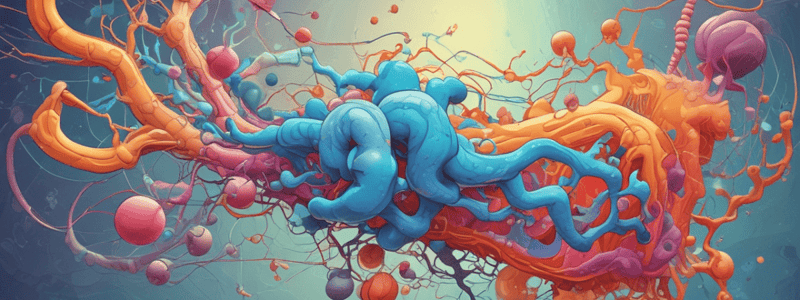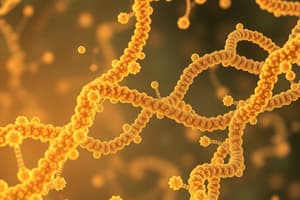Podcast
Questions and Answers
What is the primary function of tmRNA in trans-translation?
What is the primary function of tmRNA in trans-translation?
- To degrade defective tRNAs
- To recycle ribosomes stuck on truncated mRNAs (correct)
- To repair damaged mRNA molecules
- To synthesize truncated proteins
What is the main reason for ribosomal stalling?
What is the main reason for ribosomal stalling?
- Defects in ribosomal subunits
- Overproduction of tmRNA
- Lack of tRNA in the A site (correct)
- Mutations in the mRNA sequence
What is the consequence of not resolving a stalled ribosome?
What is the consequence of not resolving a stalled ribosome?
- Production of truncated proteins (correct)
- Activation of cellular stress responses
- Induction of apoptosis
- Degradation of mRNA molecules
In eukaryotes, how is a stalled ribosome typically resolved?
In eukaryotes, how is a stalled ribosome typically resolved?
What is unique about the tmRNA molecule?
What is unique about the tmRNA molecule?
What is the main function of tmRNA in the process of trans-translation?
What is the main function of tmRNA in the process of trans-translation?
What is the structure of the tmRNA molecule?
What is the structure of the tmRNA molecule?
What happens when the ribosome encounters a triplet codon out of place?
What happens when the ribosome encounters a triplet codon out of place?
What is the reason for the majority of stalled ribosomes?
What is the reason for the majority of stalled ribosomes?
What is the function of the Ala residue attached to the tmRNA?
What is the function of the Ala residue attached to the tmRNA?
What is the function of the tmRNA in prokaryotes?
What is the function of the tmRNA in prokaryotes?
What is the purpose of the stringent response in prokaryotes?
What is the purpose of the stringent response in prokaryotes?
What is the structure of the tmRNA that allows it to simulate tRNA?
What is the structure of the tmRNA that allows it to simulate tRNA?
What is the role of the alarmones in the stringent response?
What is the role of the alarmones in the stringent response?
What is the characteristic of the alarmones that allows them to act as a signal?
What is the characteristic of the alarmones that allows them to act as a signal?
What happens to the tRNA molecules when there is a lack of amino acids?
What happens to the tRNA molecules when there is a lack of amino acids?
What is the effect of RelA activation on RNA polymerase?
What is the effect of RelA activation on RNA polymerase?
What is the function of RelA?
What is the function of RelA?
What happens to the ribosome when a tRNA without an amino acid binds to it?
What happens to the ribosome when a tRNA without an amino acid binds to it?
What is the result of RelA activation on protein synthesis?
What is the result of RelA activation on protein synthesis?
Flashcards are hidden until you start studying
Study Notes
Trans-Translation
- Trans-translation is a process where a tmRNA (transfer-messenger RNA) molecule is used, which is simultaneously a tRNA and an mRNA.
- This process occurs when ribosomes stall, which can lead to a problem of producing a tail of stalled ribosomes, resulting in truncated proteins.
- In eukaryotes, the solution to this problem is to remove the ribosome and eliminate the truncated proteins, and if the messenger is incorrect, degrade it.
- In prokaryotes, the tmRNA molecule acts in place of the next aminoacyl-tRNA, freeing the stalled ribosome.
- The tmRNA molecule has a tRNA-like structure at one end with an attached Ala, and a large extension with a tertiary structure and a reading frame marked in pink.
- The tmRNA provides an alanine and a reading frame to continue, and the Ala binds the peptidyl to the tmRNA, causing the ribosome to shift.
- This leads to the ribosome leaving the real mRNA and translating the pink side of the tmRNA, allowing normal tRNAs to enter.
- The resulting proteins are tagged with Ala and the tmRNA sequence, which is a signal for proteolysis, similar to ubiquitin in eukaryotes.
- The tmRNA competes and displaces the rest of the mRNA if the stall is not caused by the end of the truncated messenger.
Stringent Response
- A more important response to amino acid scarcity is the stringent response, which occurs when cells detect a lack of amino acids.
- Prokaryotes, such as E. coli, can synthesize their own amino acids but will stop producing them if they are present in the culture medium or environment.
- When amino acids are absent, the cells change their metabolism to produce them, and if they are then removed, the cells will respond by restricting growth and protein synthesis.
- This response is triggered by alarmone molecules, which are derived from nucleotides and have a phosphate group at the 5' and 3' ends.
- Alarmone molecules are unstable and have a short half-life, ensuring that the response is temporary and only active while the signal is present.
- The absence of amino acids leads to tRNAs without amino acids, which can form a complex with EF-Tu, but not with aminoacyl-tRNAs.
- This complex activates the RelA enzyme, which produces alarmone molecules and triggers the stringent response.
- The stringent response reduces the synthesis of rRNA, tRNA, and mRNA, and increases proteolysis to generate amino acids.
Studying That Suits You
Use AI to generate personalized quizzes and flashcards to suit your learning preferences.





